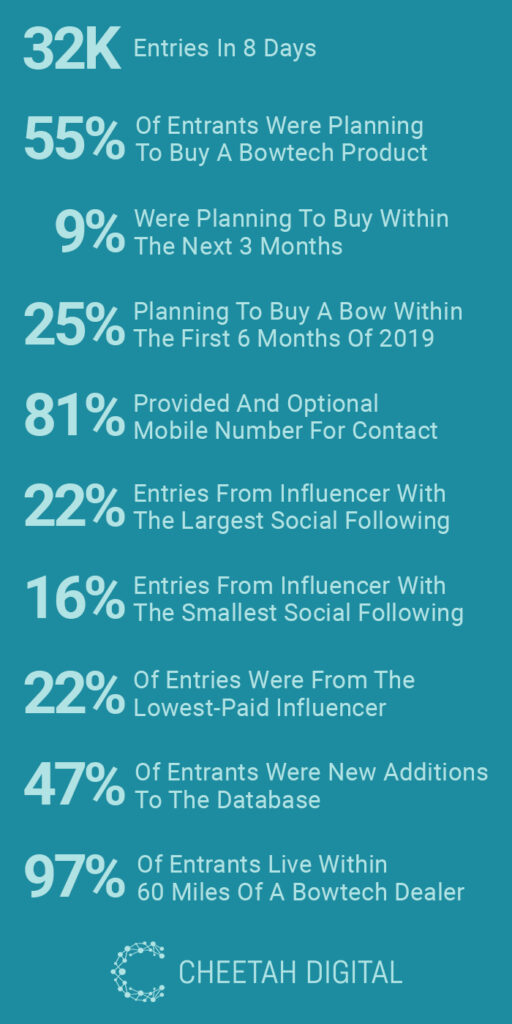Social Influencers Deliver 32k Opt-Ins in 8 Days for Bowtech
Want to watch this case study instead? Check out the video case study.
Does influencer marketing drive revenue? We’ve all asked it, especially those in charge of the budget. There are pros and cons — it’s hard to measure accurately because the metrics exist outside of your system and until you pay to run a campaign, you can never be sure of how many of an influencer’s followers are fake. But the upsides if you find a great influencer? An incredibly engaged audience that can drive profits.
This case study will answer all of your questions about what your influencer marketing strategy should really be — how you can determine if influencers are driving sales, what data or value you can get beyond fleeting promotional posts, and how you can differentiate between brands who also use influencer marketing.
Marketing Campaign Objectives
Create an “always on” strategy that would convert the social followings of key influencers into a contextualized database. Segment the acquired audience by key psychographic insights and inform both messaging and remarketing channels to deliver hyper-relevant content. Through this process, we hoped to increase paid digital effectiveness while reducing costs by delivering the right message to the right audience.
The Solution: A Marigold Grow Sweepstakes
Eight influencers were chosen and each influencer was given a unique link to a sweepstakes form and asked to promote it for eight days on Instagram and Facebook. Audiences were given the opportunity to win thousands of dollars in outdoor gear in exchange for insights on their outdoor lifestyle. There was no paid media support behind this campaign in order to measure the influencers’ true organic reach.
In this campaign, the audience of the influencers were asked several questions such as:
- When they planned to make their next outdoor purchase
- Where they planned to buy: online, in-store, or another channel
- How much they planned to spend
- Which brands they planned to purchase
- Postal code and optional mobile number
The Bowtech sweepstakes was simple to access for users on Instagram and Facebook. On Instagram, they entered the sweepstakes by swiping up from the Story. On Facebook, they used a direct link to a mobile-first experience.
Immediately upon entry, each entrant was sent a confirmation email of their sweepstakes entry — and then given a unique offer to test drive the new bow at the dealership closest to them. Bowtech was able to dynamically serve personalized geo-relevant dealership information in these emails since they required a postal code from each entrant.
Influencer marketing was incredibly difficult for us to measure. My CFO constantly reminds me that ‘likes and shares’ aren’t dollars in the bank. Our strategy of moving consumers off of social and into our own database lets us reach them directly, without an algorithm in the way, and the 150,000 psychographic data points we collected revealed each individual’s true purchase intent.
The Results
Over the eight-day, Bowtech added 32,000 people and over 120,000 data points to their database with zero paid media support. With this information, they were able to create a very effective direct-to-consumer campaign — one of the most effective in the archery industry to date. Bowtech was able to identify which influencers had the most engaged (and real) followers by the amount of form fill-outs and could measure that data instead of “likes” and “shares.”

Next Steps in the Influencer Campaign Strategy
Bowtech, using Marigold Grow, was able to segment the acquired audiences according to two crucial questions asked — which brand they currently owned and which they planned to purchase. Those custom audiences were loaded into Google Audiences to drive remarketing ads with multiple creative campaigns, each one aligning exactly to the consumer’s brand affinity.
Using dynamic creative that mentioned each consumer’s preferred brand drove tens of thousands of consumers to one of three custom videos that de-positioned those brands and elevated awareness of Bowtech’s newest product. Eroding confidence in the brand each consumer currently owned helped to drive interest for test drives of Bowtech products at dealers nationwide. Not to mention the metrics on these hyper-targeted ad campaigns had a 5x+ engagement rate over other ads using Google’s standard interest and keyword tools.
On top of that, Bowtech’s branded emails with personalized incentives and suggestions based on psychographic data collected from their audience continue today. The test drive call-to-action at a local dealership remains one of the most effective strategies they’ve implemented via email and SMS Those 32,000 entrants collected from the sweepstakes will be tapped for additional emails, paid, and other marketing campaigns in the future based on their psychographic answers.
More than a “like” or a “share” on a social post, Bowtech’s influencer strategy was a database growth strategy, one that has proven to be a great investment that will continue to provide rewards over the long term.
“We were now able to clearly identify which influencers were driving actual sales, along with which of their fans were actually brand advocates. Those insights ultimately allowed us to move less effective influencers out of the program, freeing up resources to bolster the efforts that were clearly driving real results.” Jeff Suiter, Bowtech’s Director of Marketing
